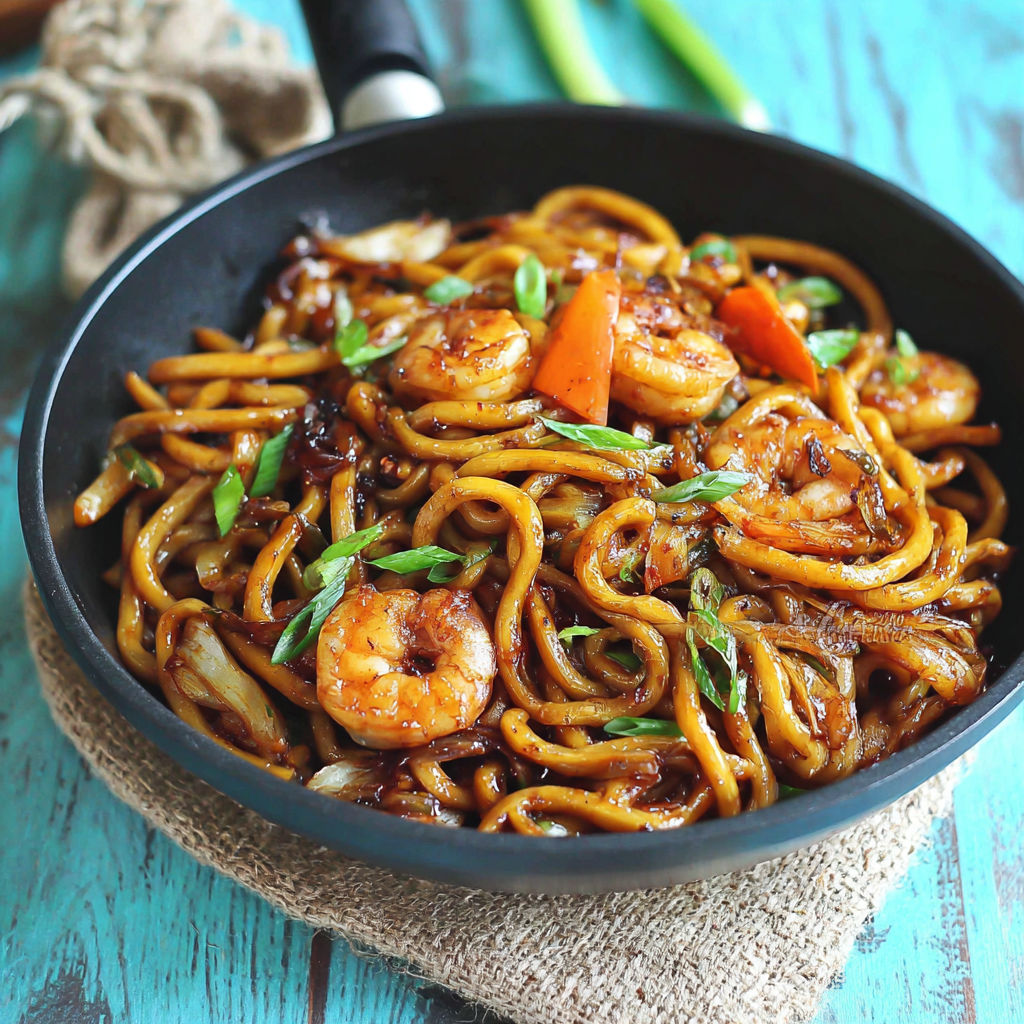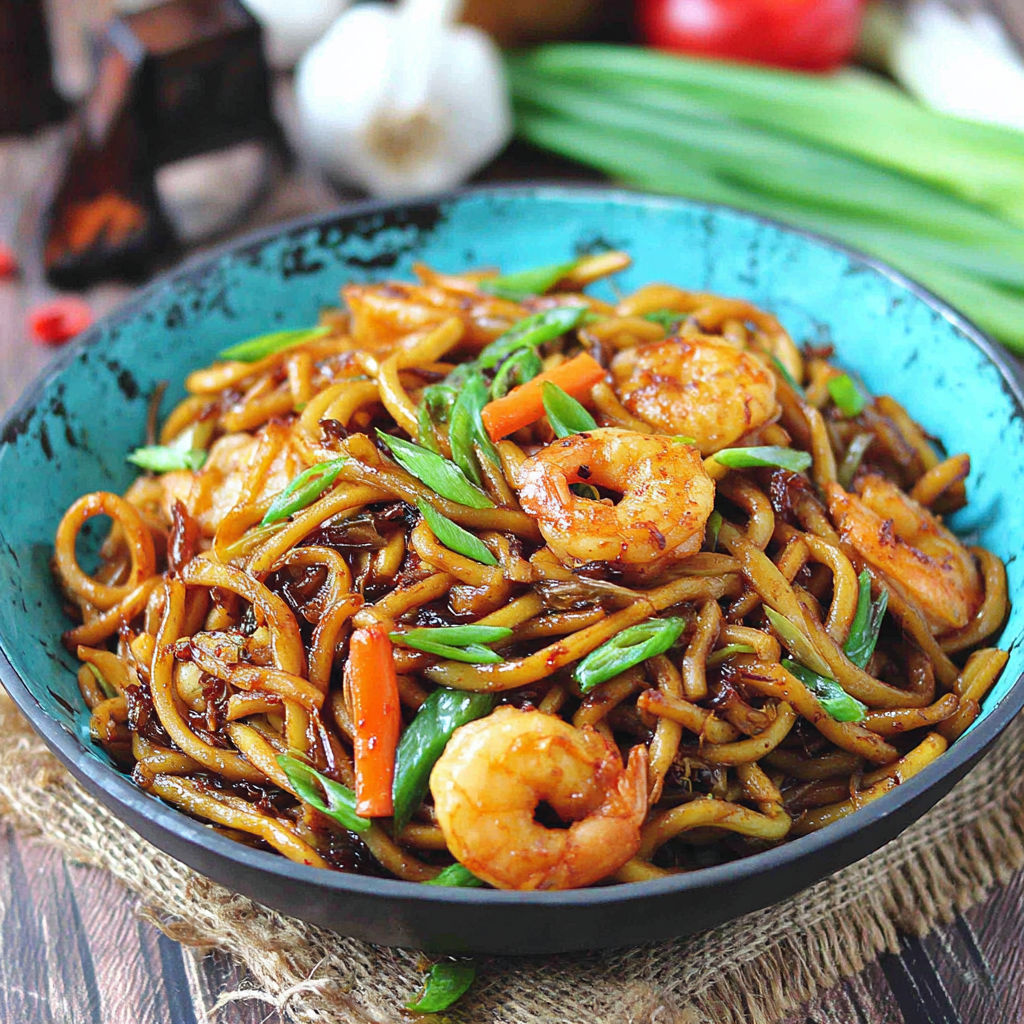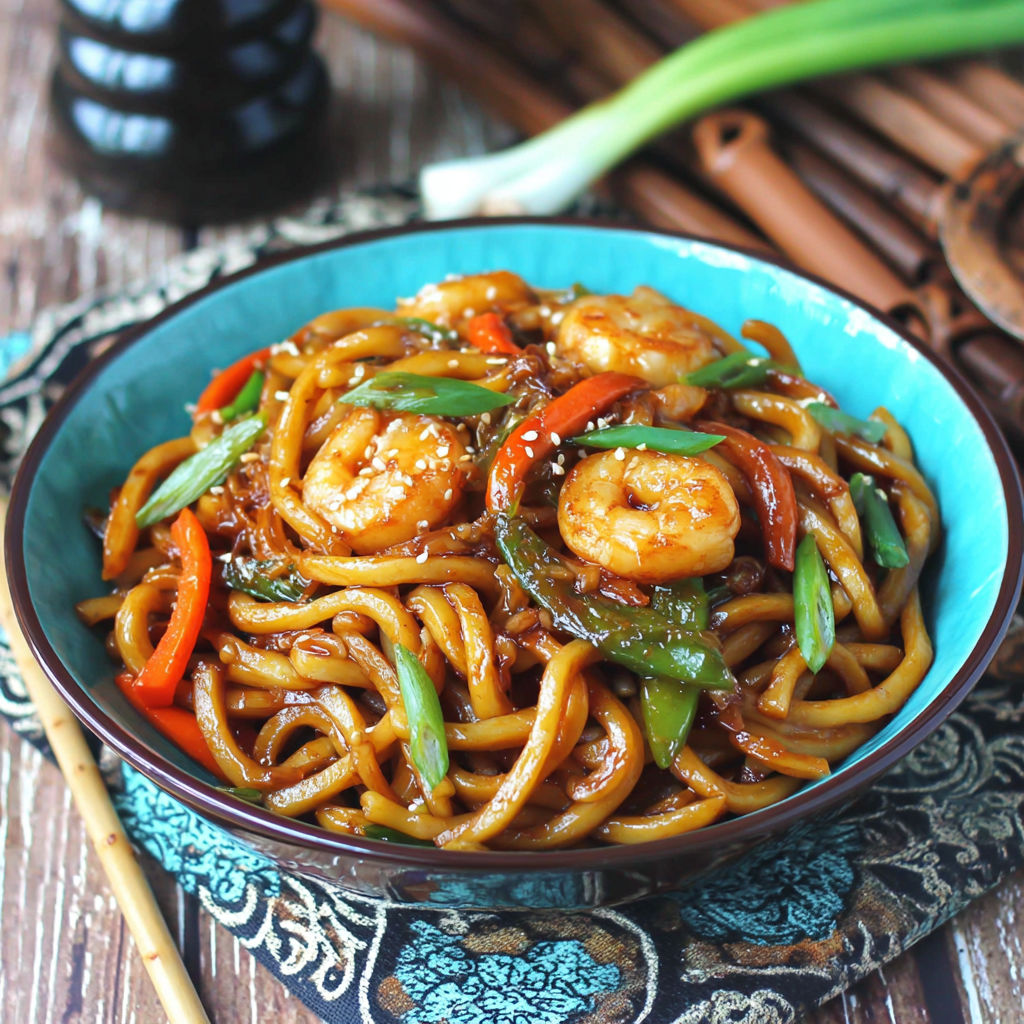 Save
Save
Yaki Udon with Shrimp is one of those weeknight dinners that always delivers savory comfort with little fuss. Thick, chewy udon noodles get tossed in a glossy umami sauce and seared with juicy shrimp plus plenty of crisp-tender veggies for a meal that comes together fast and makes you feel like you are dining out. I reach for this recipe whenever I crave takeout but want something fresher on my own table.
I first whipped this up when I was short on time but wanted to wow a friend. She still asks for my “shrimp noodles” when she visits.
Gather Your Ingredients
- Udon noodles: vacuum packed stay bouncy and moist when stir fried
- Neutral oil: grapeseed or canola prevents flavor from overpowering the dish
- Shrimp: look for large peeled ones deveined for easy eating buy fresh or thawed not pre cooked for best texture
- Garlic: fresh is best for punchy aromatic depth
- Yellow onion: adds savory-sweet rounding
- White mushrooms: adds earthiness pick smooth unwrinkled caps
- Carrot: cut matchstick style brightens the dish choose firm carrots no cracks
- Spring onion: the white adds savor green gives color and freshness
- Regular soy sauce: the backbone of Japanese stir fries use quality brands with simple ingredients
- Oyster sauce: builds savory-sweet layers in the sauce
- Dark soy sauce: a touch deepens color and umami seek out real dark soy not regular as it thickens the sauce
- Rice vinegar: wakes up the flavors while balancing richness
- Brown sugar: rounds things out with mellow sweetness go for soft unrefined if possible
- Freshly crushed black pepper: gives a peppery lift
- Toasted sesame oil: brings nutty aroma and finish check label for toasted not plain
- Salt and pepper: enhances every component use sparingly with soy based sauces
How to Make It
- Cook the Udon Noodles:
- Boil your udon noodles following package instructions. As soon as they are tender but still chewy drain and rinse with cold water to stop cooking and prevent stickiness. Drizzle lightly with oil and toss to keep separated while you prep the rest.
- Sauté the Aromatics and Mushrooms:
- Heat a tablespoon of neutral oil in a large skillet or wok over medium-high. Add minced garlic and let it sizzle for one minute until fragrant. Immediately scatter in your sliced mushrooms. Toss on high heat letting them brown and shrink for about two to three minutes.
- Stir Fry the Vegetables:
- Next add the yellow onion sliced white part of the spring onion and carrot sticks. Continue stir frying briskly for another two to three minutes so veggies begin softening but keep a little bite. Sprinkle in a little salt and pepper for base seasoning. Remove the veggies from the pan and set aside.
- Cook the Shrimp:
- Put the pan back on the heat and add the rest of the oil. Arrange the shrimp in a single layer. Splash in regular soy sauce and a tiny pinch of salt. Sauté until the shrimp are just opaque and curl into C shapes about two minutes per side. Be careful not to overcook.
- Crisp the Noodles:
- Return drained udon noodles to the pan with shrimp. Fry over high heat stirring and tossing constantly so the noodles get a bit of crispness at the edges. This helps them absorb sauce and get those signature seared bits.
- Build the Sauce:
- While noodles are crisping whisk together the oyster sauce dark soy rice vinegar brown sugar black pepper toasted sesame oil and a pinch of salt in a bowl. Pour this sauce evenly over the noodles and shrimp. Toss well so everything glistens and the aroma hits you.
- Combine and Finish:
- Return the sautéed veggie mixture to the pan. Toss everything together until the sauce coats every noodle and the vegetables are distributed. Kill the heat. Scatter the green part of the spring onion for a pop of freshness. Transfer to plates and enjoy hot.

Shrimp is my favorite ingredient in this stir fry. I love the way they absorb sauce and stay juicy if cooked just right. The first time I got them perfectly tender my family declared this dish better than restaurant noodles and it has stayed a go to ever since.
Flavor Boosters
Storage Tips: Stash leftover yaki udon in a shallow airtight container and cool promptly before refrigerating. The noodles stay fresh for up to two days but taste best reheated in a skillet with a splash of water or extra sauce to revive their bounce. Avoid microwaving directly from the fridge as this can toughen the noodles and shrimp.
Serving Suggestions
Serve piping hot straight from the pan piled into wide shallow bowls for best effect. Pair with miso soup or a simple cucumber salad to round out the meal. Sesame seeds or a dab of chili crisp make tasty finishing touches if you like a little heat and extra crunch.
Creative Twists
Ingredient Substitutions: If you cannot find fresh or vacuum sealed udon try frozen udon for great chewy texture. Soba or thick rice noodles work as an alternative in a pinch. Use thinly sliced chicken steak or even tofu in place of shrimp for a different protein spin. For veggies cabbage spinach snow peas or red bell pepper all blend beautifully with the savory sauce profile.
Cultural Notes: Yaki udon was invented in post war Japan as cooks swapped scarce soba for leftover udon noodles and stir fried whatever protein and vegetables were available. Its quick cook method and adaptability to what is on hand makes it beloved at izakayas and home tables alike.
Seasonal Adaptations: Spring swap in asparagus spears and snap peas for extra color. Summer try bell peppers and zucchini with corn kernels for sweetness. Autumn shiitake mushrooms and kale pair well with hearty sauce. Winter use napa cabbage and carrots for a warming dish.
Freezer Meal Conversion: While best fresh you can freeze cooked yaki udon in small airtight containers. Reheat from frozen directly in a nonstick pan adding a splash of water or extra sauce to help the noodles loosen and stay moist. Do not refreeze once thawed since shrimp can lose texture.
Success Stories: A friend once panicked when her kids turned up noses at mushrooms but she swapped them with edamame and carrot coins. The plates were cleared in minutes and now her family asks for yaki udon on busy nights. I love how flexible this dish can be for different tastes.

Yaki udon is pure comfort and incredibly adaptable. Once you try it this way you may never go back to ordinary stir fry noodles.
Recipe FAQs
- → What type of udon noodles work best?
Vacuum-packed udon noodles are ideal for their chewy texture, but frozen or fresh udon can also be used.
- → How do you prevent noodles from sticking?
Rinse the noodles in cold water after boiling and toss with a little oil before stir frying to keep them from sticking.
- → Can I use different vegetables?
Absolutely! Bell peppers, snap peas, or baby corn are great substitutions or additions for extra crunch.
- → Is it possible to make this dish ahead?
You can prep ingredients ahead, but for the best texture, stir fry and combine everything just before serving.
- → How do I know when shrimp are cooked?
Shrimp are ready when they turn pink and opaque. Be sure to avoid overcooking for best texture.
- → Can I make it vegetarian?
Yes, skip the shrimp and add more mushrooms or tofu, and replace oyster sauce with a vegetarian alternative.
